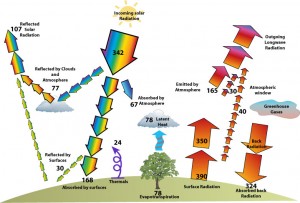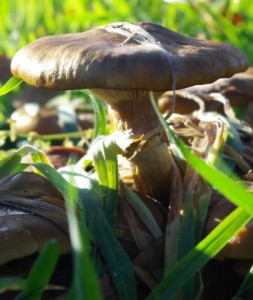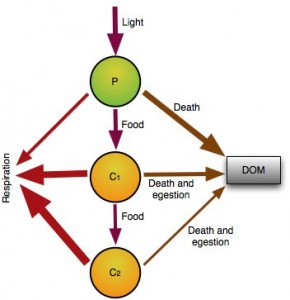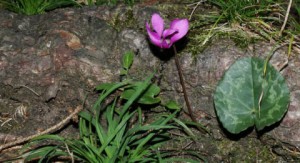2.5. 3: Energy flow through the ecosystems
 The sun produces immense amounts of energy in the form of electromagnetic radiation. This is a broad spectrum from X rays to radio waves, though most exists in the ultraviolet, visible light and infrared radiation bands. Almost half of the sun’s total radiation is visible light.
The sun produces immense amounts of energy in the form of electromagnetic radiation. This is a broad spectrum from X rays to radio waves, though most exists in the ultraviolet, visible light and infrared radiation bands. Almost half of the sun’s total radiation is visible light.
The distance of the earths orbit around the sun is fairly constant, around 1.5×10 m, and the amount of energy reaching the outer atmosphere is within 5% of a constant energy quantity of 1400 J/m2/s, this is the Earths solar constant.
The second law states that the efficiency of energy conversion to useful work is never perfect: when energy changes from one form, some of the energy is not available to do useful work in the system. It leaves the system mainly as useless heat. This is called entropy. This is true for all energy changes even those involving the living organisms.
Only a very small part of the total sunlight reaching the Earths surface is ever transformed into energy used by living organisms. A study of an Illinois cornfield suggested only 1.6% was actually used by the corn. Some of that energy becomes stored chemical energy (sugars, fats and proteins) within the plants, some is used to maintain life processes and ultimately is dissipated as heat during respiration. The stored energy can then either be passed on to consumers as food or die and enter the detritus food chain. Consumers again are inefficient processors of the energy consumed with respiration taking place and some losses immediately as faeces and so the process of flow, storages and losses continues up the food chain.
Organisms that gain energy from inorganic sources and fix it as energy rich organic molecules are called Autotrophs. Most are plants obtaining their energy directly from light, carbon dioxide and water: Photosynthetic autotrophs.
Some bacteria obtain energy directly from inorganic chemicals: chemosynthetic autotrophs.
Organisms that utilize energy rich organic molecules, edible food, for their energy supply are termed Heterotrophs. The hetrotrophs can be split into two kinds, consumers that obtain their from living organisms and decomposers that obtain theirs from dead organisms or from organic material dispersed in the environment
Autotrophs and particularly plants are the base unit of all stored energy in any ecosystem. Light energy is converted into chemical energy by photosynthesis within the cells of plants. Pigments in plant cells of which chlorophyll is the most important catalyse this reaction

